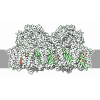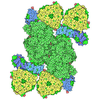+ Open data
Open data
- Basic information
Basic information
| Entry | Database: PDB / ID: 8xkl | ||||||
|---|---|---|---|---|---|---|---|
| Title | Structure of ACPII-CCPII from cryptophyte algae | ||||||
 Components Components |
| ||||||
 Keywords Keywords | STRUCTURAL PROTEIN / Photosystem II / PHOTOSYNTHESIS | ||||||
| Function / homology | Chem-8CT / CHLOROPHYLL A / Chem-IHT / Chem-II0 / Chem-II3 / Chlorophyll c2 / 1,2-DIPALMITOYL-PHOSPHATIDYL-GLYCEROLE / 1,2-DISTEAROYL-MONOGALACTOSYL-DIGLYCERIDE / Chem-SQD Function and homology information Function and homology information | ||||||
| Biological species |  Chroomonas placoidea (eukaryote) Chroomonas placoidea (eukaryote) | ||||||
| Method | ELECTRON MICROSCOPY / single particle reconstruction / cryo EM / Resolution: 2.84 Å | ||||||
 Authors Authors | Li, X.Y. / Mao, Z.Y. / Shen, J.R. / Han, G.Y. | ||||||
| Funding support |  China, 1items China, 1items
| ||||||
 Citation Citation |  Journal: Nat Commun / Year: 2024 Journal: Nat Commun / Year: 2024Title: Structure and distinct supramolecular organization of a PSII-ACPII dimer from a cryptophyte alga Chroomonas placoidea. Authors: Zhiyuan Mao / Xingyue Li / Zhenhua Li / Liangliang Shen / Xiaoyi Li / Yanyan Yang / Wenda Wang / Tingyun Kuang / Jian-Ren Shen / Guangye Han /   Abstract: Cryptophyte algae are an evolutionarily distinct and ecologically important group of photosynthetic unicellular eukaryotes. Photosystem II (PSII) of cryptophyte algae associates with alloxanthin ...Cryptophyte algae are an evolutionarily distinct and ecologically important group of photosynthetic unicellular eukaryotes. Photosystem II (PSII) of cryptophyte algae associates with alloxanthin chlorophyll a/c-binding proteins (ACPs) to act as the peripheral light-harvesting system, whose supramolecular organization is unknown. Here, we purify the PSII-ACPII supercomplex from a cryptophyte alga Chroomonas placoidea (C. placoidea), and analyze its structure at a resolution of 2.47 Å using cryo-electron microscopy. This structure reveals a dimeric organization of PSII-ACPII containing two PSII core monomers flanked by six symmetrically arranged ACPII subunits. The PSII core is conserved whereas the organization of ACPII subunits exhibits a distinct pattern, different from those observed so far in PSII of other algae and higher plants. Furthermore, we find a Chl a-binding antenna subunit, CCPII-S, which mediates interaction of ACPII with the PSII core. These results provide a structural basis for the assembly of antennas within the supercomplex and possible excitation energy transfer pathways in cryptophyte algal PSII, shedding light on the diversity of supramolecular organization of photosynthetic machinery. | ||||||
| History |
|
- Structure visualization
Structure visualization
| Structure viewer | Molecule:  Molmil Molmil Jmol/JSmol Jmol/JSmol |
|---|
- Downloads & links
Downloads & links
- Download
Download
| PDBx/mmCIF format |  8xkl.cif.gz 8xkl.cif.gz | 406.4 KB | Display |  PDBx/mmCIF format PDBx/mmCIF format |
|---|---|---|---|---|
| PDB format |  pdb8xkl.ent.gz pdb8xkl.ent.gz | 347.9 KB | Display |  PDB format PDB format |
| PDBx/mmJSON format |  8xkl.json.gz 8xkl.json.gz | Tree view |  PDBx/mmJSON format PDBx/mmJSON format | |
| Others |  Other downloads Other downloads |
-Validation report
| Summary document |  8xkl_validation.pdf.gz 8xkl_validation.pdf.gz | 7 MB | Display |  wwPDB validaton report wwPDB validaton report |
|---|---|---|---|---|
| Full document |  8xkl_full_validation.pdf.gz 8xkl_full_validation.pdf.gz | 7.2 MB | Display | |
| Data in XML |  8xkl_validation.xml.gz 8xkl_validation.xml.gz | 100.9 KB | Display | |
| Data in CIF |  8xkl_validation.cif.gz 8xkl_validation.cif.gz | 125.4 KB | Display | |
| Arichive directory |  https://data.pdbj.org/pub/pdb/validation_reports/xk/8xkl https://data.pdbj.org/pub/pdb/validation_reports/xk/8xkl ftp://data.pdbj.org/pub/pdb/validation_reports/xk/8xkl ftp://data.pdbj.org/pub/pdb/validation_reports/xk/8xkl | HTTPS FTP |
-Related structure data
| Related structure data |  38419MC  8wb4C M: map data used to model this data C: citing same article ( |
|---|---|
| Similar structure data | Similarity search - Function & homology  F&H Search F&H Search |
- Links
Links
- Assembly
Assembly
| Deposited unit | 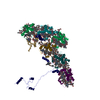
|
|---|---|
| 1 |
|
- Components
Components
-Protein , 8 types, 8 molecules 0789GPps
| #1: Protein | Mass: 23734.623 Da / Num. of mol.: 1 / Source method: isolated from a natural source / Source: (natural)  Chroomonas placoidea (eukaryote) Chroomonas placoidea (eukaryote) |
|---|---|
| #2: Protein | Mass: 25151.223 Da / Num. of mol.: 1 / Source method: isolated from a natural source / Source: (natural)  Chroomonas placoidea (eukaryote) Chroomonas placoidea (eukaryote) |
| #3: Protein | Mass: 23471.201 Da / Num. of mol.: 1 / Source method: isolated from a natural source / Source: (natural)  Chroomonas placoidea (eukaryote) Chroomonas placoidea (eukaryote) |
| #4: Protein | Mass: 24055.020 Da / Num. of mol.: 1 / Source method: isolated from a natural source / Source: (natural)  Chroomonas placoidea (eukaryote) Chroomonas placoidea (eukaryote) |
| #5: Protein | Mass: 5464.728 Da / Num. of mol.: 1 / Source method: isolated from a natural source / Source: (natural)  Chroomonas placoidea (eukaryote) Chroomonas placoidea (eukaryote) |
| #6: Protein | Mass: 23923.801 Da / Num. of mol.: 1 / Source method: isolated from a natural source / Source: (natural)  Chroomonas placoidea (eukaryote) Chroomonas placoidea (eukaryote) |
| #7: Protein | Mass: 23762.242 Da / Num. of mol.: 1 / Source method: isolated from a natural source / Source: (natural)  Chroomonas placoidea (eukaryote) Chroomonas placoidea (eukaryote) |
| #8: Protein | Mass: 30531.848 Da / Num. of mol.: 1 / Source method: isolated from a natural source / Source: (natural)  Chroomonas placoidea (eukaryote) Chroomonas placoidea (eukaryote) |
-Non-polymers , 9 types, 112 molecules 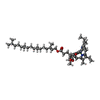

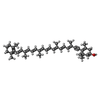

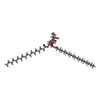

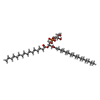
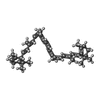
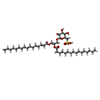








| #9: Chemical | ChemComp-CLA / #10: Chemical | ChemComp-KC2 / #11: Chemical | ChemComp-IHT / ( #12: Chemical | ChemComp-II0 / ( #13: Chemical | ChemComp-LMG / #14: Chemical | #15: Chemical | #16: Chemical | #17: Chemical | ChemComp-SQD / | |
|---|
-Details
| Has ligand of interest | Y |
|---|
-Experimental details
-Experiment
| Experiment | Method: ELECTRON MICROSCOPY |
|---|---|
| EM experiment | Aggregation state: PARTICLE / 3D reconstruction method: single particle reconstruction |
- Sample preparation
Sample preparation
| Component | Name: Structure of ACPII-CCPII from cryptophyte algae / Type: COMPLEX / Entity ID: #1-#8 / Source: NATURAL |
|---|---|
| Source (natural) | Organism:  Chroomonas placoidea (eukaryote) Chroomonas placoidea (eukaryote) |
| Buffer solution | pH: 7.5 |
| Specimen | Embedding applied: NO / Shadowing applied: NO / Staining applied: NO / Vitrification applied: YES |
| Vitrification | Cryogen name: ETHANE |
- Electron microscopy imaging
Electron microscopy imaging
| Experimental equipment |  Model: Titan Krios / Image courtesy: FEI Company |
|---|---|
| Microscopy | Model: FEI TITAN KRIOS |
| Electron gun | Electron source:  FIELD EMISSION GUN / Accelerating voltage: 300 kV / Illumination mode: FLOOD BEAM FIELD EMISSION GUN / Accelerating voltage: 300 kV / Illumination mode: FLOOD BEAM |
| Electron lens | Mode: BRIGHT FIELD / Nominal defocus max: 2000 nm / Nominal defocus min: 1000 nm |
| Image recording | Electron dose: 60 e/Å2 / Film or detector model: GATAN K3 BIOQUANTUM (6k x 4k) |
- Processing
Processing
| CTF correction | Type: PHASE FLIPPING AND AMPLITUDE CORRECTION |
|---|---|
| 3D reconstruction | Resolution: 2.84 Å / Resolution method: FSC 0.143 CUT-OFF / Num. of particles: 610800 / Symmetry type: POINT |
 Movie
Movie Controller
Controller




 PDBj
PDBj